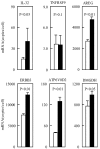Gene Expressions for Signal Transduction under Acidic Conditions
- PMID: 24705103
- PMCID: PMC3899954
- DOI: 10.3390/genes4010065
Gene Expressions for Signal Transduction under Acidic Conditions
Abstract
Although it is now well known that some diseased areas, such as cancer nests, inflammation loci, and infarction areas, are acidified, little is known about cellular signal transduction, gene expression, and cellular functions under acidic conditions. Our group showed that different signal proteins were activated under acidic conditions compared with those observed in a typical medium of around pH 7.4 that has been used until now. Investigations of gene expression under acidic conditions may be crucial to our understanding of signal transduction in acidic diseased areas. In this study, we investigated gene expression in mesothelioma cells cultured at an acidic pH using a DNA microarray technique. After 24 h culture at pH 6.7, expressions of 379 genes were increased more than twofold compared with those in cells cultured at pH 7.5. Genes encoding receptors, signal proteins including transcription factors, and cytokines including growth factors numbered 35, 32, and 17 among the 379 genes, respectively. Since the functions of 78 genes are unknown, it can be argued that cells may have other genes for signaling under acidic conditions. The expressions of 37 of the 379 genes were observed to increase after as little as 2 h. After 24 h culture at pH 6.7, expressions of 412 genes were repressed more than twofold compared with those in cells cultured at pH 7.5, and the 412 genes contained 35, 76, and 7 genes encoding receptors, signal proteins including transcription factors, and cytokines including growth factors, respectively. These results suggest that the signal pathways in acidic diseased areas are different, at least in part, from those examined with cells cultured at a pH of around 7.4.
Figures

Similar articles
-
Metabolic regulation of Escherichia coli and its phoB and phoR genes knockout mutants under phosphate and nitrogen limitations as well as at acidic condition.Microb Cell Fact. 2011 May 20;10:39. doi: 10.1186/1475-2859-10-39. Microb Cell Fact. 2011. PMID: 21599905 Free PMC article.
-
PTH ameliorates acidosis-induced adverse effects in skeletal growth centers: the PTH-IGF-I axis.Kidney Int. 2003 Feb;63(2):487-500. doi: 10.1046/j.1523-1755.2003.00773.x. Kidney Int. 2003. PMID: 12631114
-
Transcriptome profiling and functional analysis of Agrobacterium tumefaciens reveals a general conserved response to acidic conditions (pH 5.5) and a complex acid-mediated signaling involved in Agrobacterium-plant interactions.J Bacteriol. 2008 Jan;190(2):494-507. doi: 10.1128/JB.01387-07. Epub 2007 Nov 9. J Bacteriol. 2008. PMID: 17993523 Free PMC article.
-
Cancer Chemotherapy Specific to Acidic Nests.Cancers (Basel). 2017 Apr 20;9(4):36. doi: 10.3390/cancers9040036. Cancers (Basel). 2017. PMID: 28425953 Free PMC article. Review.
-
Pharmacogenomics, regulation and signaling pathways of phase I and II drug metabolizing enzymes.Curr Drug Metab. 2002 Oct;3(5):481-90. doi: 10.2174/1389200023337171. Curr Drug Metab. 2002. PMID: 12369894 Review.
Cited by
-
Acidic microenvironment plays a key role in human melanoma progression through a sustained exosome mediated transfer of clinically relevant metastatic molecules.J Exp Clin Cancer Res. 2018 Oct 5;37(1):245. doi: 10.1186/s13046-018-0915-z. J Exp Clin Cancer Res. 2018. PMID: 30290833 Free PMC article.
-
Regulation of energy metabolism in human pluripotent stem cells.Cell Mol Life Sci. 2021 Dec;78(24):8097-8108. doi: 10.1007/s00018-021-04016-0. Epub 2021 Nov 13. Cell Mol Life Sci. 2021. PMID: 34773132 Free PMC article. Review.
-
Medium acidosis drives cardiac differentiation during mesendoderm cell fate specification from human pluripotent stem cells.Stem Cell Reports. 2024 Sep 10;19(9):1304-1319. doi: 10.1016/j.stemcr.2024.07.012. Epub 2024 Aug 22. Stem Cell Reports. 2024. PMID: 39178847 Free PMC article.
-
Expression of acidosis-dependent genes in human cancer nests.Mol Clin Oncol. 2014 Nov;2(6):1160-1166. doi: 10.3892/mco.2014.344. Epub 2014 Jul 11. Mol Clin Oncol. 2014. PMID: 25279216 Free PMC article.
-
Role of microenvironmental acidity and tumor exosomes in cancer immunomodulation.Transl Cancer Res. 2020 Sep;9(9):5775-5786. doi: 10.21037/tcr.2020.03.69. Transl Cancer Res. 2020. PMID: 35117938 Free PMC article. Review.
References
LinkOut - more resources
Full Text Sources
Other Literature Sources

